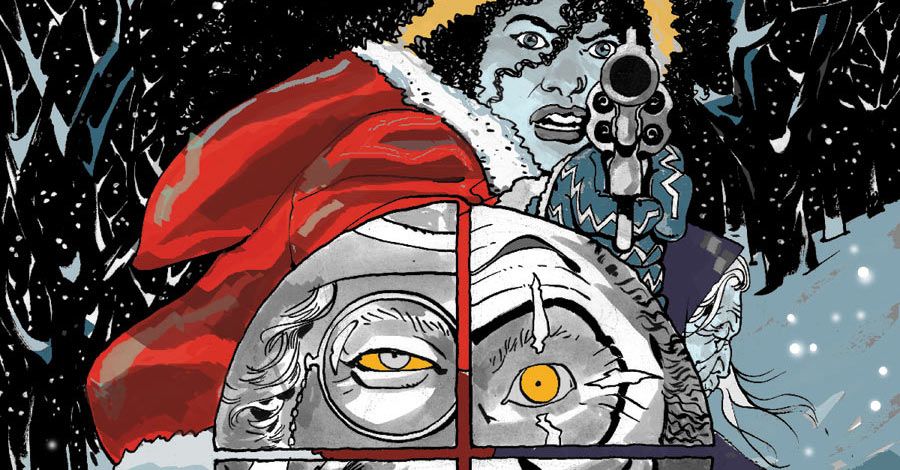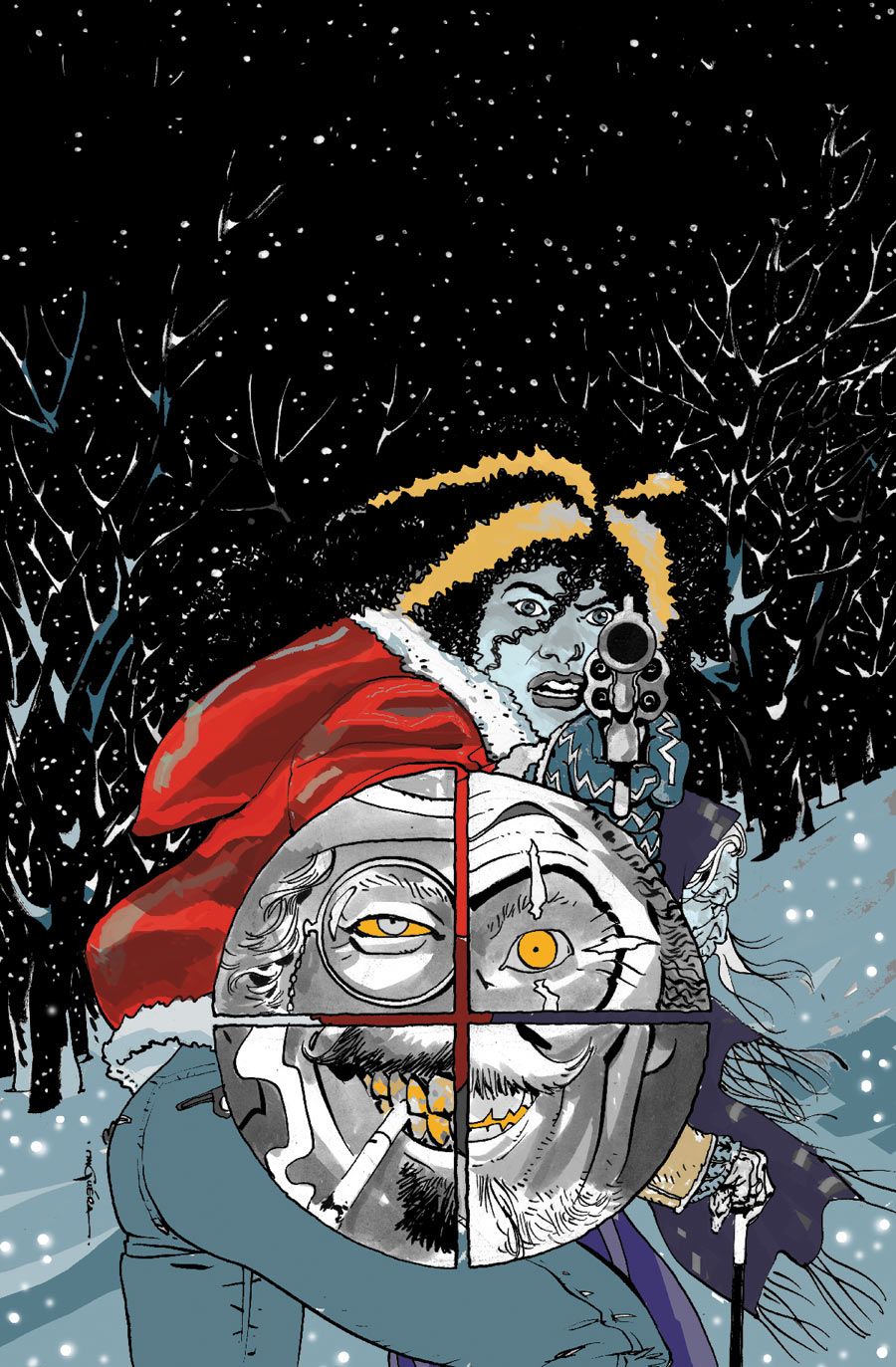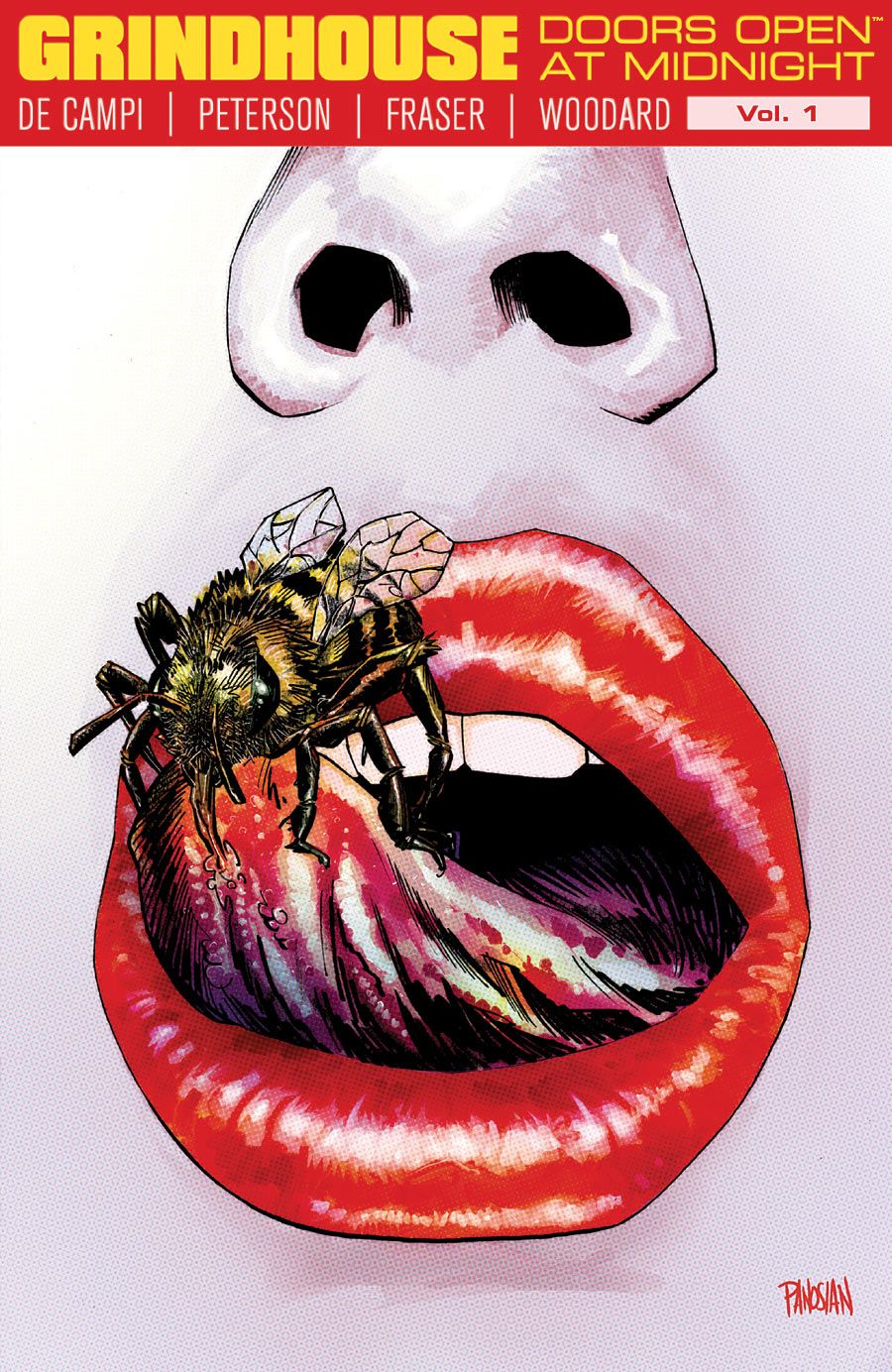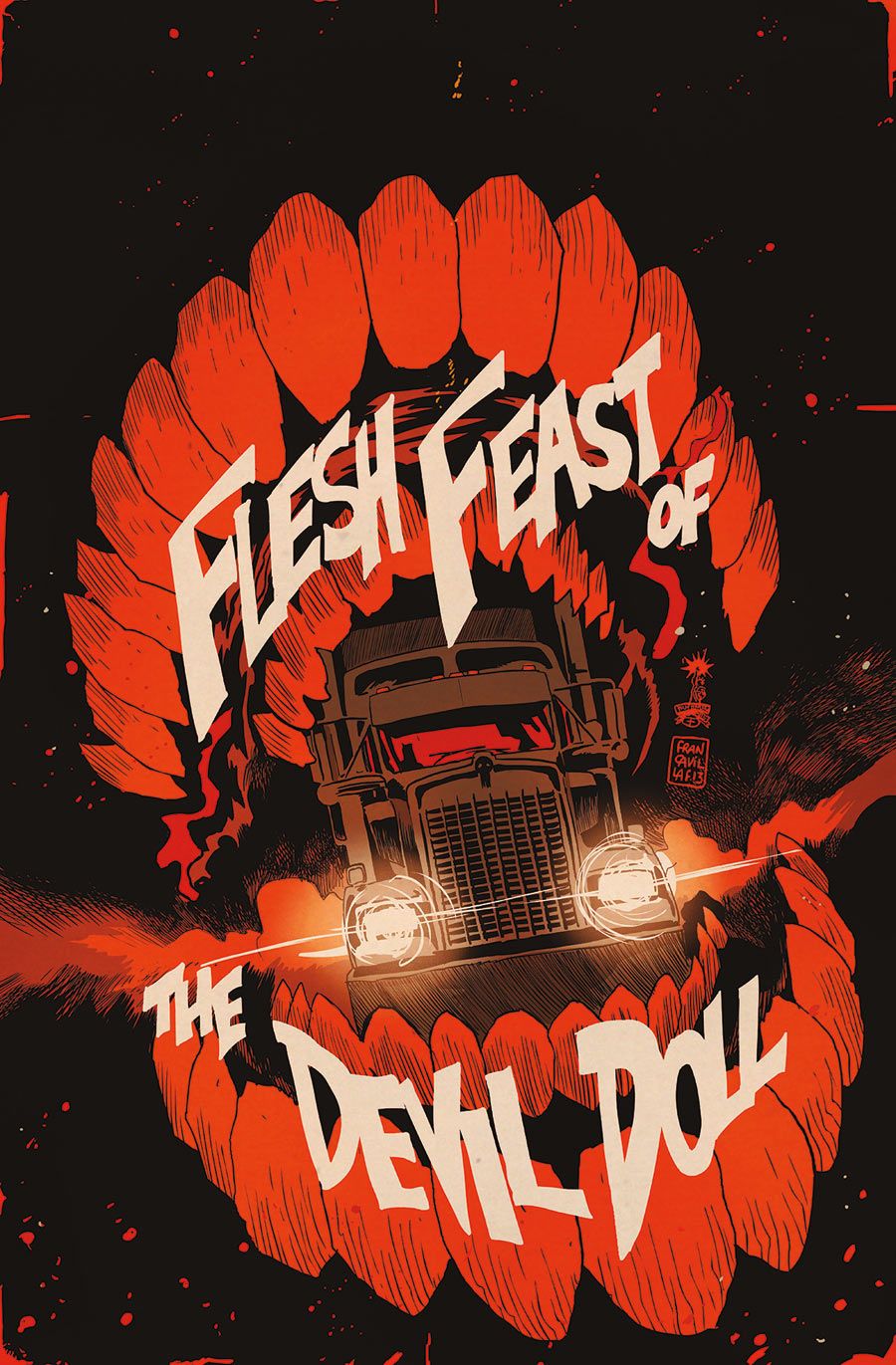This November sees sordid suspense stalk the spinner rack once more, as Alex de Campi and art collaborators including R.M Guera, Chris Peterson, Afua Richardson and Ulises Farina gather for "Grindhouse: Drive In, Bleed Out!"
Following last year's series of outrageous exploitation stories from de Campi and Co, this second season sees Dark Horse once more daring to publish some of the darkest, most shocking stories it can, with all kinds of tales heading up the eight-issue series this time round, including be blaxpoitation, sexploitation, and -- uh, beesploitation.
In order to learn more about the return of her horror anthology, how the project came to be, and what fresh terrors readers can expect from this second season -- the series final season -- CBR News spoke with de Campi about her return to the wonderfully depraved world of "Grindhouse."
Remember: the only thing more terrifying than one season of "Grindhouse" is two seasons!
CBR News: For those who aren't aware -- what's the general concept of a Grindhouse? What does the term mean, and what made you want to bring the Grindhouse sensibility to comics?
Alex de Campi: A grindhouse was a crappy '60s or '70s cinema that couldn't afford first-run films so played films with, uh, other appeal -- horror, sexploitation, blaxploitation, martial arts films -- many were all night or had midnight showings of especially racy or scandalous films. The floors were sticky. They smelled. There was probably only one screen (I know, right?). The term "grindhouse" then became a catchall for Z-grade films of that era and beyond, encompassing everything from the Italian slasher and horror flicks of Argento and Fulci, through to horrific rape-revenge stuff, to frankly wooden and silly sci-fi sexploitation flicks like "Galaxina." There was a gleeful trashiness to all of it -- even in "The Texas Chainsaw Massacre" (the original), Leatherface dances off into the sunset with his beloved chainsaw at the end.
Now, a ton of gore isn't a new thing in comics (I blame "Watchmen"). After all, DC's Free Comic Book Day comic had Black Canary's face cut off and stapled onto some dude's chest, something I don't expect to see outside a Takashi Miike film. Marvel's big summer event involved the Watcher's eyes being gouged out. But sex? And a certain glee in trashiness? That's not around much.
Most of the violence is po-faced, in the juvenile belief that uber-violence lends legitimacy and realness when in fact it's just boring most of the time. So, we're making schlock. Fun, happy schlock that you can read and it's not hateful towards women and/or people of color and/or LGBT who are usually the first to get cut up in the white boys" serious gritty comics of serious seriousness.
In short: we wanted to make the comics your mother warned you about.
How was the response from readers to Season one of the comic? Aside from, y'know, mortal horror and all that.
I thought I was doing this trashy thing that not many people would get or be interested in but would make me and my art teams super happy -- but in fact we became this crazy sleeper hit that got written up everywhere and way exceeded its sales estimates and -- we were just awed and humbled by how much it took off. People got it! And most importantly, the horror crowd got it.
The horror audience is a hugely disparate group, but in general they are all very well educated about their genre and keen to try out new things in it. It's an odd duck of a series because it has an appeal to the mainstream Comic Book Dude (Violence! Gore! Bewbs!) but also to female readers, as most of the protagonists are female.
I can't explain the line I walk -- it's so fine, and done so by a sort of echolocation, to keep the sex and gore quotient up -- but in a way that get women excited too. "It has a female protagonist" (or worse, "it has a strong female character in it!") is no guarantee women will flock to it because seriously, a lot of female protagonist stuff I've read has made me roll my eyes so hard I could see my own brain.
"Grindhouse" was also a great series for retailers to hand-sell, because two issues get you a complete story. The format turned out to be quite unusual/groundbreaking, which I didn't realize at the time (I accidentally conned Dark Horse into giving me my own personal anthology series, basically.) This is eight issues, which are made up of four completely disparate two-issue stories, each with its own art team and with no relation to the other stories in the mini.
The first season was "Bee Vixens from Mars" (small town alien sexploitation/female vigilante); "Prison Ship Antares" (women in prison -- in space); "Bride of Blood" (rape-revenge in the middle ages); and "Flesh Feast of the Devil Doll" (summer camp slasher / teen girl gang).
Will there be any continuity between the first season and the second? Will any characters be returning?
We have our "Bee Vixens" heroine, one-eyed Latina sheriff's deputy Garcia, coming back in "Blood Lagoon" -- with the same art team, Chris Peterson on line and Nolan Woodard on color. I'm working out how to make that story even more depraved than "Bee Vixens."
When last you spoke to CBR, you mentioned the possibility of "Blood Lagoon" becoming a reality -- so how did the sequel stitch itself together?
Yes! Issues #5-6 of Season Two are "Blood Lagoon." Can't wait to work with those two reprobates again. They opened the first season so strongly -- got us noticed, got a ton of people on board thanks to their art -- and we've all gotten so much more depraved since then. The boys thought up the title for the story and somewhere there is a plot for it they wrote -- possibly on Facebook, under the photo of the scarlet waste pool of a large-scale rural abattoir that inspired the story.
After the first season brought marauded hockey camps, bee vixens, space prisons -- all sorts of different types of stories within the general tone of exploitation entertainment -- what can readers expect from season two? Where do you go from here?
Our first story is a "rural giallo", "Slay Ride." It's also a Christmas story, because nothing says holidays like misery, violence and terror. Oh, and sex. Then Afua Richardson and I bring you "Lady Danger, Agent of B.O.O.T.I.," our homage to blaxploitation films. That's probably the least depraved of our stories but also one of the most fun. Then the aforementioned "Blood Lagoon," and finally I burn all my bridges with space sexploitation "Nebulina" aka "Le Voyage Fantastique de Veronique" and Ulises Farinas.
Then, we drop the mic. That's it. No season 3. Especially after what I have planned in "Nebulina." Go out with a bang. Ulises is always saying how he doesn't get to draw crazy enough stuff. I am going to try to out-crazy Ulises. Most of the story is in my head already. It's -- colossally wrong.
How did you meet the various artists? Did you come to them with a pitch for a story, or did you pitch the project as a whole and develop a story later which is tailored to them?
I came to them with a fairly complete story -- I have a clear idea of who I want to work with, so the story is tailored in advance to that artist's style and strengths. Usually, they're friends I know from twitter or whatever. Sometimes, even, from real life (shocker!).
"Slay Ride," the first story you mentioned, will bring R.M. Guera along as artist -- what about his artwork made you approach him for the start of "Grindhouse?"
We're old friends. We worked together on a short section of "Ashes," and I've always wanted to do more with him. He can do violence and absurdity like nobody else, and his people look so real (which makes it worse!). Rajko is so in demand that we probably couldn't do a series together except a well-paid work for hire thing (*coughcoughWINTERSOLDIERMAXcough*), but two issues? We can do that.
Over the last few years, Santa has not often been a figure of dread -- what's your take on Jolly Saint Nick?
Santa isn't actually a figure of dread in this, but it all takes place on Christmas Eve and -- well, it's like a cross between "Funny Games" and "Candyman," but more unsettling and wrong.
"Grindhouse" essentially has to bring violence, sex and a sense of gleeful gratuitousness to each issue. Is it hard to replicate that effect for story after story, and make sure you heighten things?
Mm, not really. We just start wrong and go downhill from there. I've always had a terribly filthy mind, and a great tendency to free-associate, which are wonderful things to have while writing grindhouse. It has to be unforced, though. You can tell when people are trying too hard to shock.
Are there points where you start to worry things are getting too out of hand? Is there ever a feeling that you need to tone the content down a little?
What is this "too much" you speak of?
No, seriously. Each story naturally varies in its level of nastiness -- some are quite nasty indeed, some are tamer. But I've never felt the need to hold back. Holding back isn't the point of this series. The people with morals and taste at Dark Horse have long since given up even looking at my book. We're left alone over in our dark, sticky, cherry-scented corner to do whatever we darn well please.
Is it tempting to roll your eyes along with the reader as things go bonkers each issue, or do you work hard to ensure that you're playing all this in as straight-faced a manner as possible?
No part of the series is ever meant as satire, but there is a gleeful abandon to it in the way we create it -- same as there were for many of the movies that inspired us. I think the reading experience is fairly gleeful, too -- to be fair none of this is stuff we spend a lot of time analyzing. The book's creation process is very fast, dirty and intuitive, which is a nice change from my otherwise painfully slow and surgically precise way of writing. (Slow in terms of time it takes to write the story, not in terms of pacing. My pacing skews pretty fast.)
How do you pull the scripts together? Do you have a careful structure for each story, or do you prefer first to come up simply with the concept and see just how far you can take it?
I think a lot about the story and sketch out some rough notes. The title and an idea of subgenre or two come first -- then, much noodling in the back of my mind while I'm working on other things (or walking dogs, or at my part-time job, or lying in bed at night.) I know by the time I've come up with an opening scene, and the ending scene, I'm ready to write the story. I then do a rough outline, and just plow in. Then the script goes to the artist, the artist gives me notes (as does my editor) and we do a final draft.
As mentioned, the stories will be told in two-issue arcs. What drew you to that structure for the series?
Two issues is a great length. I mean, good God, does anyone really want to read six issues of "Bee Vixens from Mars?" Get in, tell something short and shonky and gross, and get out -- that's our modus.
I think where grindhouse-inspired projects have gone wrong before is in attempting to keep up the frenetic, crazed pace over five or more issues. It's just hard. It gets boring for everyone involved. Or (my favorite), it's too long and it's such awful white dude power fantasy that you're like, "Ew" and feel unclean after reading it. "'Scuse me, your id is showing."
Also, I wanted to play around in several grindhouse subgenres, so doing several short stories under a thematic banner of "Grindhouse" felt right to me. It's been a wonderful way to work. I'd highly recommend it to anyone else wanting to splash around in this nice warm ocean of blood.
One of the best things about having only two issues is you learn the wisdom of the great Berry Gordy: "Don't bore us, get to the chorus." Get that story started! No waffling. You need to have grabbed your reader's attention by the first page turn. It's definitely sharpened my skills at crafting compelling openings to stories.
So there's no chance of Season 3?
There won't be a Season 3. We want to do two really solid seasons, then leave. It's not like we have to get to 99 episodes for syndication, or anything. In terms of other genres -- oh, I have love for so many of them, but I have a couple pressing projects happening on the heels of this and just as "Grindhouse" was a wonderful break from the more serious works of "Smoke"/"Ashes" and (the sadly as yet unpublished) "Margaret the Damned," the new series are a nice diversification from "Grindhouse." They all have that sort of element, though. Once you start throwing in nasty curveballs and absurdity into your stories, it kinda tends to stick.
What else are you working on at the moment? Where can people find you and your work online?
"Grindhouse" volume 1 (a double feature, collecting Season One, issues #1-4) and my spy thriller tome "Smoke"/"Ashes" are both out from Dark Horse, via their app and all finer comic stores. My webcomic "Valentine" relaunches on Thrillbent and comiXology on September 18; I have a supernatural horror series with Jerry Ordway starting in Dark Horse Presents #4 in November, and then a whole bunch of things that aren't announced yet.
Including, I can say, my first "Big Two" superhero story.
Online, I tumbl at alexdecampi.tumblr.com and tweet at @alexdecampi. Website is alexdecampi.com. Hurrah for having a weird name.




